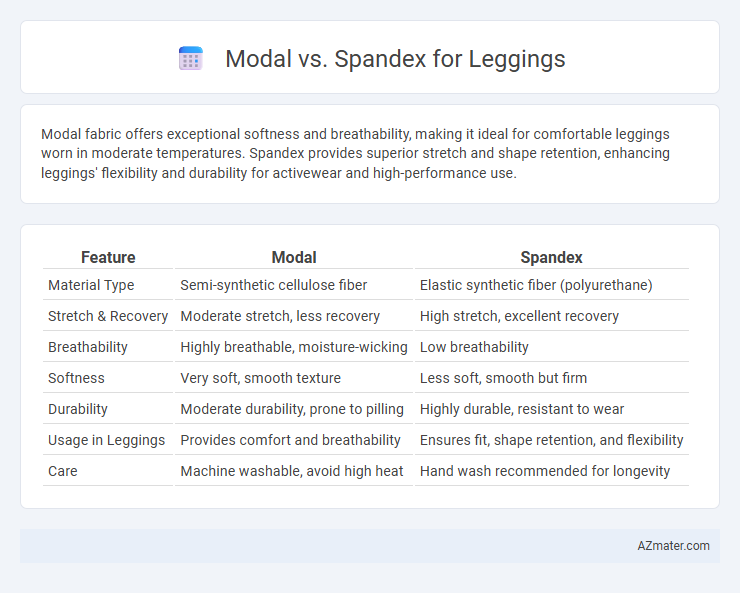Modal fabric offers exceptional softness and breathability, making it ideal for comfortable leggings worn in moderate temperatures. Spandex provides superior stretch and shape retention, enhancing leggings' flexibility and durability for activewear and high-performance use.
Table of Comparison
| Feature | Modal | Spandex |
|---|---|---|
| Material Type | Semi-synthetic cellulose fiber | Elastic synthetic fiber (polyurethane) |
| Stretch & Recovery | Moderate stretch, less recovery | High stretch, excellent recovery |
| Breathability | Highly breathable, moisture-wicking | Low breathability |
| Softness | Very soft, smooth texture | Less soft, smooth but firm |
| Durability | Moderate durability, prone to pilling | Highly durable, resistant to wear |
| Usage in Leggings | Provides comfort and breathability | Ensures fit, shape retention, and flexibility |
| Care | Machine washable, avoid high heat | Hand wash recommended for longevity |
Introduction to Modal and Spandex Fabrics
Modal is a semi-synthetic fiber made from beech tree pulp, prized for its softness, breathability, and moisture-wicking properties, making it ideal for comfortable leggings. Spandex, also known as elastane or Lycra, is a synthetic fiber renowned for its exceptional elasticity and ability to stretch up to five times its original length, providing superior fit and flexibility. Combining modal's smooth texture with spandex's stretch creates leggings that offer both comfort and durability for active wear.
What is Modal?
Modal is a semi-synthetic fabric made from beech tree cellulose, known for its softness, breathability, and moisture-wicking properties, making it highly comfortable for leggings. It offers excellent durability and maintains its shape well, resisting shrinkage and pilling over time. Unlike Spandex, which provides stretch and flexibility, Modal emphasizes a silky feel and smooth texture, often blended with other fibers for enhanced performance in activewear.
What is Spandex?
Spandex, also known as elastane or Lycra, is a synthetic fiber renowned for its exceptional elasticity, allowing leggings to stretch significantly while retaining their original shape. This fabric enhances comfort and durability, making it ideal for activewear such as leggings that require flexibility and form-fitting qualities. Unlike Modal, which is a natural fiber derived from beech trees and prized for softness and breathability, Spandex primarily contributes to stretch and support in legging fabrics.
Key Differences Between Modal and Spandex
Modal fabric offers exceptional softness and breathability, making it ideal for comfortable leggings with a smooth, silky feel. Spandex provides superior stretch and shape retention, ensuring leggings maintain their fit during intense physical activity. Modal is often blended with spandex to combine comfort and flexibility, resulting in durable, form-fitting leggings.
Comfort and Feel: Modal vs Spandex
Modal fabric offers superior softness and breathability, making leggings exceptionally comfortable for all-day wear, while spandex provides unmatched stretch and shape retention, ensuring a snug, flexible fit. Modal's natural fibers absorb moisture effectively, enhancing comfort during physical activities, whereas spandex's elastic properties allow leggings to maintain their form and support muscle movement. Combining modal with spandex often results in leggings that balance softness with durability and stretch, maximizing both comfort and functionality.
Durability and Longevity Comparison
Modal fabric offers superior softness and breathability but tends to be less durable than spandex, as it can weaken with frequent washing and extended wear. Spandex, known for its exceptional elasticity and resistance to wear and tear, maintains legging shape and resilience over time, making it ideal for high-performance and activewear. Combining modal and spandex blends enhances durability and longevity, providing comfort alongside sustained fabric strength.
Moisture-Wicking and Breathability
Modal fabric offers superior moisture-wicking properties compared to spandex, efficiently drawing sweat away from the skin to keep you dry during workouts. Spandex excels in breathability due to its lightweight and stretchable nature, allowing better airflow and comfort in leggings. Combining modal's moisture management with spandex's breathability results in leggings that enhance performance and comfort during intense physical activities.
Stretch and Flexibility in Leggings
Modal fabric offers a soft, smooth texture with moderate stretch, making leggings comfortable for everyday wear but less optimal for intense physical activity. Spandex, known for its exceptional elasticity, provides superior stretch and flexibility, enabling leggings to move effortlessly with the body during workouts or yoga sessions. Combining modal with spandex creates leggings that balance softness and durable stretch, enhancing both comfort and performance.
Best Uses for Modal vs Spandex Leggings
Modal leggings offer superior breathability and moisture-wicking properties, making them ideal for yoga and low-impact workouts where comfort and softness are a priority. Spandex leggings provide exceptional stretch and shape retention, making them perfect for high-intensity activities like running or gym training that require flexibility and durability. Choosing between Modal and Spandex leggings depends on the desired balance of comfort, elasticity, and performance for specific exercise routines.
Final Verdict: Which is Better for Leggings?
Modal leggings offer superior softness, breathability, and moisture-wicking properties, making them ideal for comfortable everyday wear. Spandex leggings excel in stretchability and shape retention, providing excellent support during physical activities and workouts. For a perfect balance of comfort and flexibility, a blend of Modal and Spandex is often the best choice for high-performance and stylish leggings.

Infographic: Modal vs Spandex for Legging
 azmater.com
azmater.com